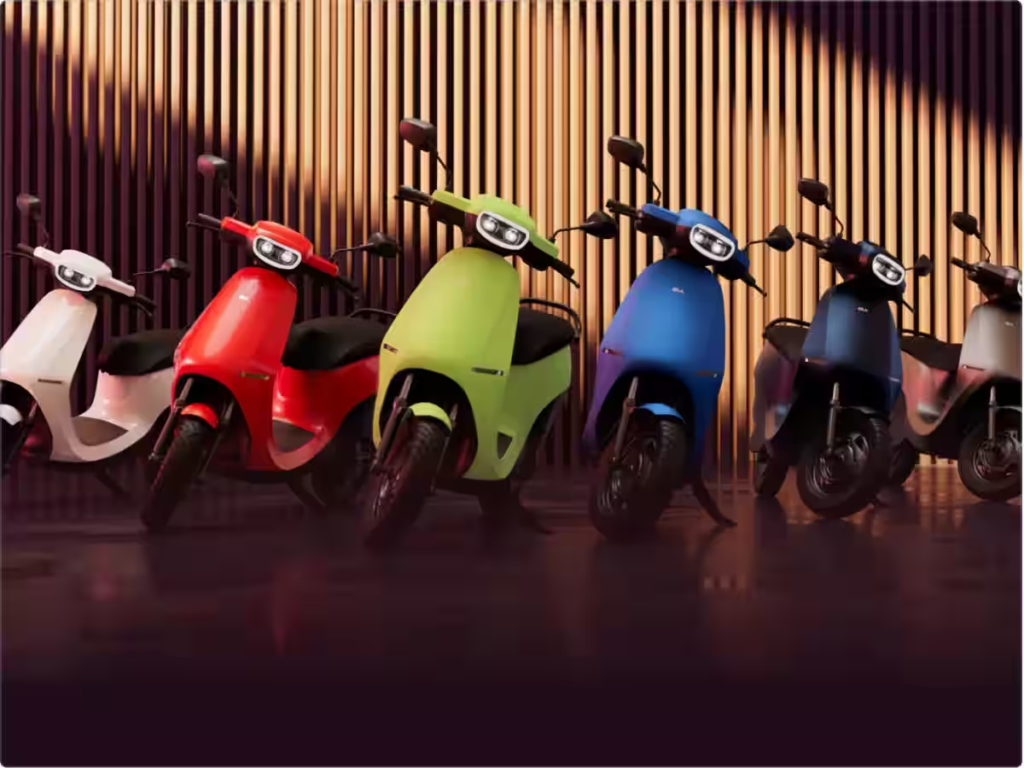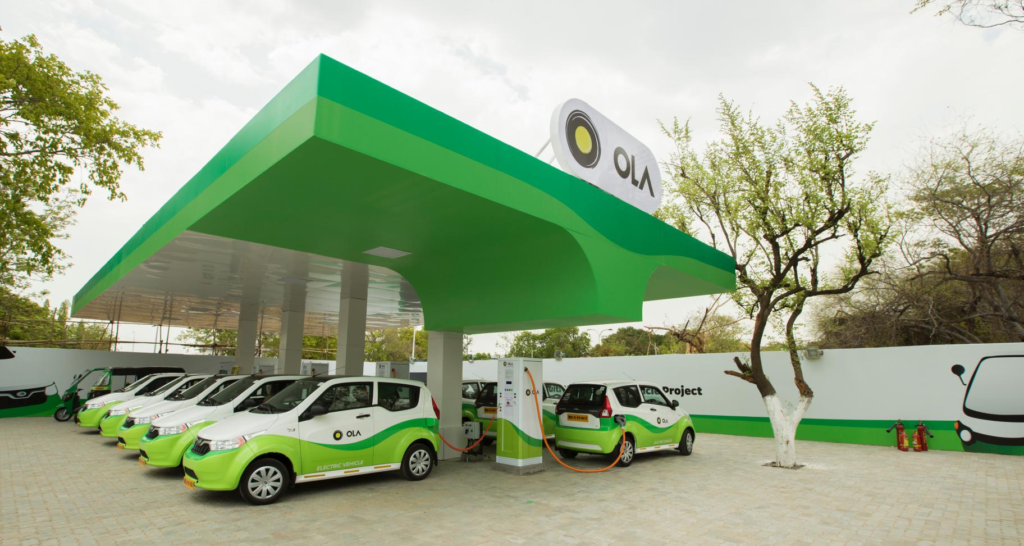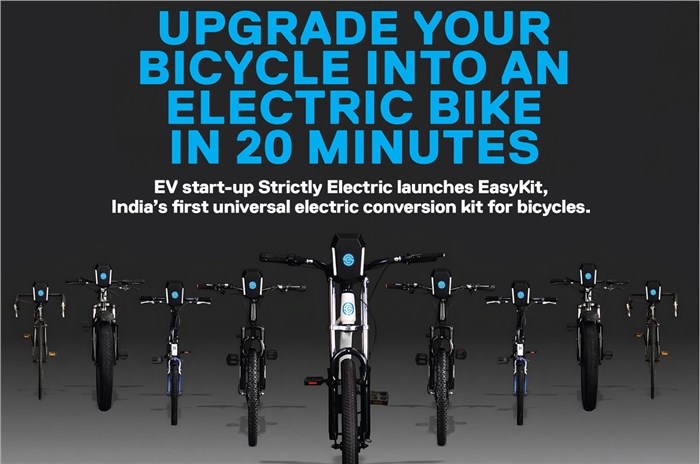A Strategic Leap: Ola Electric’s $385 Million Funding Fuels India’s EV Aspirations
In a move that’s making headlines, Ola Electric has successfully secured a whopping $385 million in funding. The investment round was spearheaded by Temasek and State Bank of India (SBI), two major players in the financial landscape.

But why is this funding round capturing so much attention? Well, it’s not just about the numbers. This investment is a significant milestone in India’s rapidly growing Electric Vehicle (EV) market. With the government pushing for greener alternatives, Ola Electric’s fresh capital is set to accelerate the nation’s shift to sustainable mobility.

People also read:
Best Luxury Electric Cars in India
Acer Joins Forces With EBikeGo To Break Into India’s Booming Electric Scooter Market
So, buckle up as we delve into how this funding could be a game-changer, not just for Ola Electric, but for the entire Indian EV ecosystem.
Unpacking Ola Electric’s $385 Million Funding Round Details
The Numbers Speak Volumes
Let’s talk figures. Ola Electric has successfully raised Rs 3,200 crore, which translates to around $385 million. That’s not pocket change; it’s a substantial investment that signals strong confidence in the company’s vision.
Lead investors: Temasek and SBI
Who’s backing this venture? The funding round was led by Temasek and State Bank of India (SBI). These aren’t just any investors; they’re financial heavyweights with a keen eye for promising ventures. Their involvement adds an extra layer of credibility to Ola Electric’s ambitious plans.
Where Will the Money Go?
So, what’s the plan for this sizable investment? Ola Electric has earmarked the funds for two major initiatives. First, they aim to expand their existing EV business, which is already making waves in the market. Second, they’re setting up India’s first lithium-ion cell manufacturing facility. This is a big deal, as it positions the company at the forefront of India’s green energy revolution.

In summary, this funding round isn’t just about injecting capital into Ola Electric. It’s about fueling a vision for a cleaner, greener India. With these funds, the company is poised to accelerate its role in transforming the nation’s transportation landscape.
Government’s Role: How Policy Backing Amplifies Ola Electric’s Ambitions
A Spot in the Cell PLI Scheme
It’s not just investors who are betting big on Ola Electric; the Indian government is in the game too. The company has been selected under the government’s ambitious cell Production-Linked Incentive (PLI) scheme. This is a clear signal that the authorities see Ola Electric as a key player in India’s green transition.
Allocation of a Maximum Capacity of 20 GWh
What does this selection mean in practical terms? Well, Ola Electric has been allocated a maximum capacity of 20 GWh under the PLI scheme. This is a significant quota, allowing the company to produce a large volume of lithium-ion cells. It’s a strategic move that aligns with India’s broader goals to become a global hub for electric vehicles and green technology.
In essence, the government’s backing adds another layer of validation to Ola Electric’s plans. It’s not just about financial investment; it’s about institutional support that can pave the way for transformative changes in India’s transportation and energy sectors.
Manufacturing Milestones: From Krishnagiri to a Global Footprint
Setting the Stage in Krishnagiri, Tamil Nadu
Ola Electric is not just stopping at raising funds; it’s putting them to immediate use. The company has announced plans to set up a lithium-ion cell manufacturing facility in Krishnagiri, Tamil Nadu. This strategic location offers a host of benefits, including proximity to key suppliers and a robust infrastructure network.
Phased Scaling Up To 100 GWh
But Ola Electric isn’t thinking small. The initial setup in Krishnagiri will start with a capacity of 5 GWh in its first phase. The company has grand plans to scale this up, aiming for a whopping 100 GWh at full capacity. This phased approach allows Ola Electric to test the waters while having a clear roadmap for exponential growth.
In summary, Ola Electric’s manufacturing plans are as ambitious as they are strategic. With an initial foothold in Krishnagiri and a vision to scale up significantly, the company is well on its way to becoming a linchpin in India’s EV ecosystem.
Ola Electric’s Product Portfolio
Current Focus on Two-wheelers
Ola Electric has been making waves with its focus on two-wheelers. The company understands the Indian market’s affinity for these convenient and cost-effective vehicles. It’s not just about electric cars; two-wheelers are a significant part of the EV revolution.
Introduction of a New Motorcycle Line-up Scheduled for Next Year
Hold onto your helmets! Ola Electric is gearing up to diversify its product range. The company has announced plans to introduce a new line-up of electric motorcycles by the end of next year. This move aims to cater to a broader audience and tap into the growing demand for varied electric mobility options.
In a nutshell, Ola Electric is not just sticking to one lane. With a current focus on two-wheelers and an exciting motorcycle range on the horizon, the company is set to accelerate its presence across different segments of the EV market.
Ola Electric’s Previous Funding and Valuation
Summary of Previous Funding Rounds and Key Investors
Ola Electric has been a magnet for investors, and it’s easy to see why. In the past few months alone, the company has secured funding from notable names like Temasek, Blue Investments, and Tiger Global. These rounds have been a mix of equity and debt, showcasing investor confidence in the brand.
Current Valuation of the Company Post-allotment: Rs 44,410 crore or $5.4 billion
Here’s a number that will make you sit up and take notice: Ola Electric is now valued at a staggering Rs 44,410 crore or $5.4 billion post-allotment. This is a significant leap from its $5 billion valuation just last year. The numbers speak for themselves, signaling a robust financial standing and a promising future.
In summary, Ola Electric’s financial journey has been nothing short of impressive. With a series of successful funding rounds and a valuation that keeps soaring, the company is well-positioned to lead the EV market in India.
Unveiling Ola Electric’s Stakeholder Landscape
Major Stakeholders in the Game
When it comes to stakeholders, Ola Electric has some big names on its roster. SoftBank leads the pack as the largest external stakeholder, holding a significant 23.6% share. They’re followed by other influential players like Tiger Global and Matrix, who have also invested heavily in the company’s vision.
CEO Bhavish Aggarwal’s Stake
Let’s talk about the man steering this electric ship, shall we? Founder and CEO Bhavish Aggarwal holds a commanding 36.6% stake in Ola Electric. His significant share underscores not just his commitment but also his confidence in the company’s trajectory.
In a nutshell, the stakeholder landscape of Ola Electric is both diverse and robust, featuring a mix of industry giants and visionary leadership. This strong backing is yet another reason why Ola Electric is poised to redefine India’s EV market.
Ola Electric in the Competitive Landscape
Ather Energy’s Recent Funding
First, let’s acknowledge the elephant in the room—Ather Energy. They recently secured $108 million in funding from existing backers like GIC and Hero MotoCorp. That’s a significant amount, but it’s worth noting that Ola Electric’s recent funding dwarfs this figure.
Comparative Positioning Ola Electric and Ather Energy
So, how do these two giants stack up in the market? Ola Electric, with its massive funding and government backing, seems poised to take a larger slice of the EV pie. Ather Energy, although a strong contender, has a smaller war chest and less government support.
In terms of product offerings, Ola Electric is diversifying with new motorcycle line-ups, while Ather Energy is yet to announce such expansions. This gives Ola a slight edge in capturing a broader consumer base.
To sum it up, while Ather Energy is certainly a force to reckon with, Ola Electric appears to have the upper hand, both financially and strategically. The race is far from over, but Ola Electric seems to be off to a flying start.
Glimpses of Ola Electric’s Financial Health
Operating Revenue and Losses for FY22
Let’s talk money. Ola Electric posted an operating revenue of Rs 373 crore in FY22. That’s a staggering jump from just Rs 0.86 crore in FY21. Clearly, the company is on an upward trajectory.
The Flip Side: Rising Losses
However, it’s not all sunshine and rainbows. The company also reported a fourfold increase in losses, reaching Rs 784 crore in FY22. While this might raise eyebrows, it’s essential to consider the context.
What Does This Mean for Ola Electric’s Future?
The increased losses are likely due to manufacturing expenses and overhead costs. These are typical growing pains for a company aggressively scaling its operations. With its recent funding and government backing, Ola Electric seems well-equipped to navigate these financial challenges.
In a nutshell, while the losses are a concern, they appear to be a calculated risk. Ola Electric is investing in its future, and if all goes according to plan, the payoff could be enormous.
Steering Towards a Greener Tomorrow: The Final Takeaway
Ola Electric’s Calculated Gambit
Ola Electric is making strategic moves to dominate India’s EV market. From securing a massive funding round to setting up a lithium-ion cell manufacturing facility, the company is leaving no stone unturned. It’s not just about electric scooters; they’re also expanding into motorcycles and possibly cars.
The Domino Effect on the Industry
Ola Electric’s aggressive strategy could serve as a catalyst for the entire EV industry in India. Their initiatives, especially in manufacturing, could potentially lower the cost of EVs, making them more accessible to the average consumer.
People also read:
Electric Bikes Vs. Electric Motorcycles: Your Simple Guide To Picking The Right Ride
Why There is not Electric Bicycle Under 10000 INR in India?
The Bigger Picture: Sustainable Mobility
But it’s not just about market share or revenue. Ola Electric’s vision aligns with a larger goal – transitioning India towards sustainable mobility. Their efforts could significantly reduce the country’s carbon footprint, making a lasting impact on environmental conservation.
In summary, Ola Electric is not just accelerating its own growth but is also driving the momentum for a greener, more sustainable future for India. It’s a win-win, both for the company and the country.




